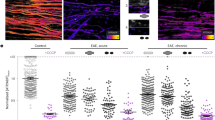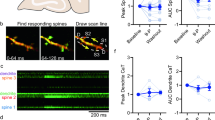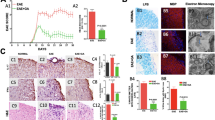Abstract
Multiple sclerosis is a neuroinflammatory disease associated with axonal degeneration1,2. The neuronally expressed, proton-gated acid-sensing ion channel-1 (ASIC1)3,4 is permeable to Na+ and Ca2+, and excessive accumulation of these ions is associated with axonal degeneration5. We tested the hypothesis that ASIC1 contributes to axonal degeneration in inflammatory lesions of the central nervous system (CNS). After induction of experimental autoimmune encephalomyelitis (EAE), Asic1−/− mice showed both a markedly reduced clinical deficit and reduced axonal degeneration compared to wild-type mice. Consistently with acidosis-mediated injury, pH measurements in the spinal cord of EAE mice showed tissue acidosis sufficient to open ASIC1. The acidosis-related protective effect of Asic1 disruption was also observed in nerve explants in vitro. Amiloride, a licensed and clinically safe blocker of ASICs, was equally neuroprotective in nerve explants and in EAE. Although ASICs are also expressed by immune cells, this expression is unlikely to explain the neuroprotective effect of Asic1 inactivation, as CNS inflammation was similar in wild-type and Asic1−/− mice. In addition, adoptive transfer of T cells from wild-type mice did not affect the protection mediated by Asic1 disruption. These results suggest that ASIC1 blockers could provide neuroprotection in multiple sclerosis.
This is a preview of subscription content, access via your institution
Access options
Subscribe to this journal
Receive 12 print issues and online access
$209.00 per year
only $17.42 per issue
Buy this article
- Purchase on Springer Link
- Instant access to full article PDF
Prices may be subject to local taxes which are calculated during checkout




Similar content being viewed by others
References
Lovas, G., Szilagyi, N., Majtenyi, K., Palkovits, M. & Komoly, S. Axonal changes in chronic demyelinated cervical spinal cord plaques. Brain 123, 308–317 (2000).
Kornek, B. et al. Multiple sclerosis and chronic autoimmune encephalomyelitis: a comparative quantitative study of axonal injury in active, inactive and remyelinated lesions. Am. J. Pathol. 157, 267–276 (2000).
Wemmie, J.A. et al. Acid-sensing ion channel 1 is localized in brain regions with high synaptic density and contributes to fear conditioning. J. Neurosci. 23, 5496–5502 (2003).
Waldmann, R., Champigny, G., Bassilana, F., Heurteaux, C. & Lazdunski, M. A proton-gated cation channel involved in acid-sensing. Nature 386, 173–177 (1997).
Stys, P.K. & Lopachin, R.M. Mechanisms of calcium and sodium fluxes in anoxic myelinated central nervous system axons. Neuroscience 82, 21–32 (1998).
Waxman, S.G. Ions, energy and axonal injury: towards a molecular neurology of multiple sclerosis. Trends Mol. Med. 12, 192–195 (2006).
Lassmann, H. Multiple sclerosis: is there neurodegeneration independent from inflammation? J. Neurol. Sci. 259, 3–6 (2007).
Dutta, R. et al. Mitochondrial dysfunction as a cause of axonal degeneration in multiple sclerosis patients. Ann. Neurol. 59, 478–489 (2006).
Stys, P.K. General mechanisms of axonal damage and its prevention. J. Neurol. Sci. 233, 3–13 (2005).
Wemmie, J.A., Price, M.P. & Welsh, M.J. Acid-sensing ion channels: advances, questions and therapeutic opportunities. Trends Neurosci. 29, 578–586 (2006).
Zha, X.M., Wemmie, J.A., Green, S.H. & Welsh, M.J. Acid-sensing ion channel 1a is a postsynaptic proton receptor that affects the density of dendritic spines. Proc. Natl. Acad. Sci. USA 103, 16556–16561 (2006).
Xiong, Z.G. et al. Neuroprotection in ischemia: blocking calcium-permeable acid-sensing ion channels. Cell 118, 687–698 (2004).
Steinman, L. & Zamvil, S.S. How to successfully apply animal studies in experimental allergic encephalomyelitis to research on multiple sclerosis. Ann. Neurol. 60, 12–21 (2006).
Benson, C.J. et al. Heteromultimers of DEG/ENaC subunits form H+-gated channels in mouse sensory neurons. Proc. Natl. Acad. Sci. USA 99, 2338–2343 (2002).
Bitsch, A. et al. Inflammatory CNS demyelination: histopathologic correlation with in vivo quantitative proton MR spectroscopy. AJNR Am. J. Neuroradiol. 20, 1619–1627 (1999).
Aboul-Enein, F. et al. Preferential loss of myelin-associated glycoprotein reflects hypoxia-like white matter damage in stroke and inflammatory brain diseases. J. Neuropathol. Exp. Neurol. 62, 25–33 (2003).
Graumann, U., Reynolds, R., Steck, A.J. & Schaeren-Wiemers, N. Molecular changes in normal appearing white matter in multiple sclerosis are characteristic of neuroprotective mechanisms against hypoxic insult. Brain Pathol. 13, 554–573 (2003).
Immke, D.C. & McCleskey, E.W. Lactate enhances the acid-sensing Na+ channel on ischemia-sensing neurons. Nat. Neurosci. 4, 869–870 (2001).
Mamet, J., Baron, A., Lazdunski, M. & Voilley, N. Proinflammatory mediators, stimulators of sensory neuron excitability via the expression of acid-sensing ion channels. J. Neurosci. 22, 10662–10670 (2002).
Allan, S.M., Tyrrell, P.J. & Rothwell, N.J. Interleukin-1 and neuronal injury. Nat. Rev. Immunol. 5, 629–640 (2005).
Cannella, B. & Raine, C.S. The adhesion molecule and cytokine profile of multiple sclerosis lesions. Ann. Neurol. 37, 424–435 (1995).
Escoubas, P. et al. Isolation of a tarantula toxin specific for a class of proton-gated Na+ channels. J. Biol. Chem. 275, 25116–25121 (2000).
Trapp, B.D. et al. Axonal transection in the lesions of multiple sclerosis. N. Engl. J. Med. 338, 278–285 (1998).
Kleyman, T.R. & Cragoe, E.J. Jr. Amiloride and its analogs as tools in the study of ion transport. J. Membr. Biol. 105, 1–21 (1988).
Craner, M.J., Hains, B.C., Lo, A.C., Black, J.A. & Waxman, S.G. Co-localization of sodium channel Nav1.6 and the sodium-calcium exchanger at sites of axonal injury in the spinal cord in EAE. Brain 127, 294–303 (2004).
Craner, M.J. et al. Molecular changes in neurons in multiple sclerosis: altered axonal expression of Nav1.2 and Nav1.6 sodium channels and Na+/Ca2+ exchanger. Proc. Natl. Acad. Sci. USA 101, 8168–8173 (2004).
Beeton, C. et al. Kv1.3 channels are a therapeutic target for T cell–mediated autoimmune diseases. Proc. Natl. Acad. Sci. USA 103, 17414–17419 (2006).
Chen, C.C., England, S., Akopian, A.N. & Wood, J.N. A sensory neuron–specific, proton-gated ion channel. Proc. Natl. Acad. Sci. USA 95, 10240–10245 (1998).
Wemmie, J.A. et al. The acid-activated ion channel ASIC contributes to synaptic plasticity, learning, and memory. Neuron 34, 463–477 (2002).
Craner, M.J. et al. Temporal course of upregulation of Nav1.8 in Purkinje neurons parallels the progression of clinical deficit in experimental allergic encephalomyelitis. J. Neuropathol. Exp. Neurol. 62, 968–975 (2003).
Acknowledgements
We thank C. Pugh's laboratory for assistance with HIF-1α western blotting. Work in the authors' laboratories is supported by the Danish (L.F.) and UK Medical Research Councils (L.F., A.V.), the Karen Elise Jensen Foundation, the Lundbeck Foundation, the Danish Multiple Sclerosis Society, the European Union (European Commission Descartes Prize and FP6 Neuropromise, Functional Genomics in Mutant Mouse Models as Tools to Investigate the Complexity of Human Immunological Disease (Mugen) and Autoimmunity and Rheumatic Disease Research Groups (ARDIS)) and G.B. Holding (Viby) ApS (L.F.). M.A.F. is supported by the Deutsche Forschungsgemeinschaft (DFG FR1720/1-1) and the Medical Research Council Career Development Fellowship. R.E. is supported by the Schweizerische Multiple Sklerose Gesellschaft and a Berrow Scholarship.
Author information
Authors and Affiliations
Contributions
M.A.F. and L.F. formulated the hypothesis and initiated and organized the study. M.A.F. and M.J.C. performed the main experimental work and analyzed the data. R.E. and S.V. helped with some experimental procedures. L.F. oversaw the experiments, analyzed the data and provided the main funding for the research. A.V. contributed to data discussion. M.A.F. and M.J.C. drafted the manuscript and L.F. and A.V. helped with writing the final manuscript. J.A.W. and M.J.W. generated Asic1−/− mice and the antibody to ASIC1 and contributed to data discussion.
Corresponding author
Ethics declarations
Competing interests
The Medical Research Council UK has filed a patent application entitled "Treatment for demyelinating disease" (priority US filing no. 60/830681, priority GB filing no. 0614058.6; priority date 14th July 2006), which is based on the research described in this paper. M.A.F. and L.F. are listed as inventors in this application.
Supplementary information
Supplementary Text and Figures
Supplementary Figures 1 & 2, Supplementary Tables 1–4 and Supplementary Methods (PDF 2977 kb)
Rights and permissions
About this article
Cite this article
Friese, M., Craner, M., Etzensperger, R. et al. Acid-sensing ion channel-1 contributes to axonal degeneration in autoimmune inflammation of the central nervous system. Nat Med 13, 1483–1489 (2007). https://doi.org/10.1038/nm1668
Received:
Accepted:
Published:
Issue Date:
DOI: https://doi.org/10.1038/nm1668
This article is cited by
-
Molecular determinants of ASIC1 modulation by divalent cations
Scientific Reports (2024)
-
CEGA: a method for inferring natural selection by comparative population genomic analysis across species
Genome Biology (2023)
-
Physiologically relevant acid-sensing ion channel (ASIC) 2a/3 heteromers have a 1:2 stoichiometry
Communications Biology (2023)
-
ASIC1a affects hypothalamic signaling and regulates the daily rhythm of body temperature in mice
Communications Biology (2023)
-
Implications of immunometabolism for smouldering MS pathology and therapy
Nature Reviews Neurology (2023)



